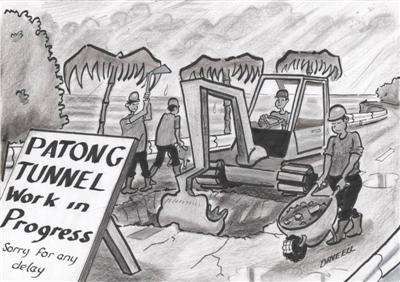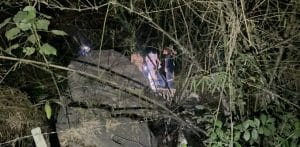Opinion: Nature punishing man’s folly in Phuket

Developments in recent weeks underscore the need for better engineering design when planning construction projects on the island.
Phuket was able to withstand centuries of tin mining with enough of its natural beauty intact to subsequently develop into a world-class tourist destination.
Yet as destructive as tin mining was, its legacy has been no match for the environmental destruction that has resulted from the poorly regulated development of the island as a tourist destination.
Man may appear to have emerged the ‘winner’ following the island’s last great clash with nature: the earthquake that caused the 2004 tsunami disaster.
Areas that celebrated a somber and dumbstruck New Year’s Eve after the tsunami, with no electricity after unthinkable losses in human life and property, are now back to their ‘former glory’.
Tailor shops, trinket stalls and massage parlors once again occupy every square meter of available space in popular tourist areas, with only the odd arson attack or shootout to put pause to commerce.
The tsunami that flattened Patong less than five years ago is now only marked by the presence of commemorative tsunami videos and magazines which compete for space on vendors’ stalls with pirated DVDs.
The forces of nature have not given up the fight, however.
Last weekend parts of the poorly-reinforced roof of one of the island’s major retailers blew off over the weekend, causing a public panic but, fortunately, no injuries.
Before that we learned that monsoon-season currents had obliterated – or at least buried – much of the Coral Reef Squadron artificial reef project in Bang Tao Bay.
Back on dry land, a large sinkhole suddenly appeared on the Patong side of hilly Phra Barami Road last week, nearly gobbling up Patong Mayor Pian Keesin as he passed in his car.
The fate of the Coral Reef Squadron and Patong Hill road, both predicted in this space, are just two examples of the kind of inadequate engineering design found all over the island.
In the case of the artificial reef, it is hard not to feel sorry for the many groups that made the project happen, as it was an experimental project driven largely by unselfish motives.
Still, from an engineering standpoint, the idea of dropping objects designed for lift in a light fluid (air) into a much denser fluid (water) should have prompted better testing prior to deployment.
Less sympathy can be felt for those responsible for the Patong Hill sinkhole, which like the roof collapse was a disaster waiting to happen.
Fortunately there were no deaths or injuries in either case.
Ironically, Patong Mayor Pian is an outspoken proponent of building a tunnel under the same said hill and relaxing the provincial statute that forbids development of land over 80 meters.
It will be interesting to see how his recent experience and the recent flooding in Patong shifts his perspective on these policies, if at all.
— The Editor
Latest Thailand News
Follow The Thaiger on Google News:


























